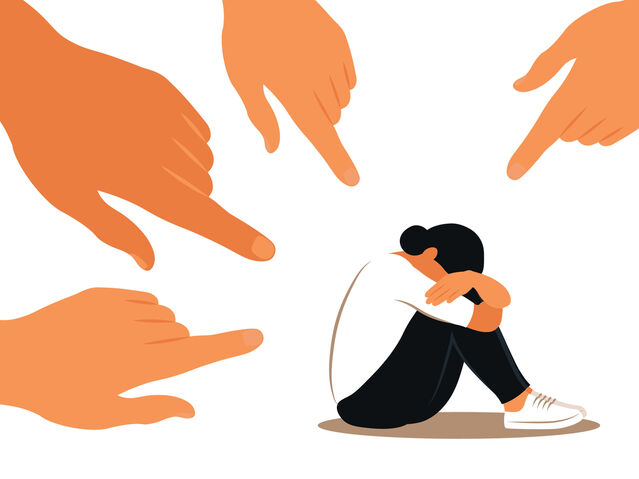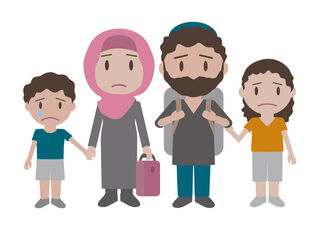Depression
The Subtle Art of Blaming the Victim
Blaming people for their problems is common and harmful. Why does it persist?
Posted March 22, 2021 Reviewed by Kaja Perina

The term “blaming the victim” evokes images of defense attorneys or sexist pundits blaming sexual assault survivors for their experience of rape (“Look how provocatively she dressed!”), or politicians who blame poor people for their poverty (“They’re lazy! They’d rather collect welfare than work!”).
This kind of obvious victim-blaming can be extremely harmful. It shames and pathologizes people for their experience of harm, and locates the cause of their problems inside of them. It says, “You are suffering because of something about you, something you’ve done or simply the way you are.”
Blaming the victim allows us to avoid seeing our own culpability for the ways we may inadvertently benefit from, or contribute to, the victimization of others. By locating the cause of distress within those who suffer, we can avoid the discomfort and hard work of facing and changing the policies and practices that generate harm. Think of cultural norms that tolerate and promote aggression towards women. Or economic policies that generate and maintain poverty—a minimum wage that fails to lift people out of poverty, healthcare costs that bankrupt families, tax incentives that reward companies for moving abroad, and leaving behind a wake of economic devastation.
Blaming survivors of rape for their attacks, or poor families for their poverty, are obvious forms of victim-blaming. They’re easy to spot, and the harm they cause is clear, as is their self-serving function of deflecting our attention away from the root causes of social and psychological problems.
My focus in this post is on less obvious forms of victim-blaming, what I call “the subtle art of blaming the victim”. It underlies a host of psychological and social interventions that are designed with genuinely good intentions, but which perpetuate the same ideology of locating the source of problems in those who experience them. Subtle victim-blaming is rarely malicious or intended to harm. Its roots may lie at least partly in what psychologists call the fundamental attribution error (FAE), the tendency to overlook contextual or situational factors that shape the experience and behavior of other people. At the same time, as the examples below illustrate, subtle victim-blaming also serves to shift attention away from the social determinants of distress--the inequalities and discriminatory laws and behaviors that are at the root of so much suffering.
To illustrate this idea, here are a few examples:
- Preventing depression among immigrant women
Years ago, an intervention was implemented to prevent depression among immigrant Latina women in a large American city. It was based on the principles of cognitive-behavioral therapy (CBT) and taught women how to recognize and change maladaptive thoughts and beliefs that might increase their risk of depression.
What it failed to address were the harsh conditions in which many of these women lived: poverty, domestic violence, discrimination, street crime, and a lack of social support (many had left behind family and friends in Mexico or Central America). Why were these women at increased risk of depression? Their lives were hard. The most effective way of preventing depression would have been to work with them, their families and communities, and the city to address those harsh conditions, not to alter their supposedly maladaptive thoughts and beliefs.
- Strengthening parenting in refugee and immigrant families
Refugee and immigrant parents face a host of stressful conditions that have been found to negatively affect their parenting. Such conditions include, for example, extreme poverty, unsafe and overcrowded housing, discrimination, and a lack of access to work. Under conditions of persistently high stress, coupled with whatever trauma and grief they may carry from their homeland, they may struggle to respond with warmth and patience to their children (click here to learn more). In a recent review article, Hend Eltanamly and her colleagues found that highly stressed refugee parents were more likely to use harsh parenting practices (yelling, hitting) and less likely to engage in warm and responsive behaviors with their kids. Other studies have found the same pattern. In response, academic psychologists and non-governmental organizations have developed parent-training programs designed to improve parenting in immigrant and refugee families. The primary focus of such interventions is on strengthening parenting by increasing knowledge and skill in the concepts and methods of “positive parenting”, an evidence-based set of ideas and practices linked to healthy child development.

What parent training programs fail to address, when they prioritize the teaching of positive parenting, is the powerful impact of parental stress and distress on parenting. Such programs adopt a deficit view of problematic parenting, viewing it as a lack (or deficit) of essential knowledge and skills. In this way, they locate the cause of the problem within parents themselves.
Alternatively, by working with parents to strengthen their wellbeing, and by targeting the sources of their stress and distress, interventions could empower parents to make greater use of the knowledge and skills they already possess, as well as those learned in the intervention. Happily, a shift is underway towards this strengths-based approach, with several promising interventions prioritizing parental wellbeing as a key pathway to strengthening parenting (Miller et al., 2020; Sim et al., 2020; Stark et al., 2018). This doesn’t negate the important role of training in positive parenting; all parents can benefit from learning such evidence-based methods of child-rearing. It simply acknowledges that refugee and immigrant parents, like parents everywhere, already possess a great deal of knowledge and skill that is compromised by their persistently high stress.
- Helping women leave abusive relationships
For decades, psychologists have been fascinated with the question of why battered women stay in abusive relationships. Oddly, this question has garnered far more interest than the more pressing question of why men use violence against their partners. The proposed explanations of why women stay have nearly all focused on factors inside the women themselves. For example, “innate female masochism” was proposed by psychoanalyst Helene Deutsch, who believed that women actually enjoyed the abuse. More compassionately (and less bizarrely), psychologist Lenore Walker proposed a learned helplessness explanation.
In Walker’s view, women stay in abusive relationships because they mistakenly believe they cannot leave (this is the core tenet of learned helplessness theory: the mistaken belief that one cannot escape a painful situation). If we could just change women’s mistaken beliefs about their efficacy, their capacity to get out safely, Walker suggested, they would be far more likely to leave the abuse behind.

What Walker’s mistaken application of learned helpless theory failed to address is that many battered women make repeated attempts to leave, but the community resources they and their children need in order to stay safe and to survive economically are often unavailable, leading them to either return to their abuser, or avoid leaving at all. Their beliefs about the enormous difficulty of a safe escape are not cognitive distortions (learned helplessness), but an accurate perception of the very real danger they face and the lack of a viable path to safety and survival. To learn more, see Eduard Gondolf's excellent book, Battered Women as Survivors: An Alternative to Treating Learned Helplessness.
To address intimate partner violence in ways that do not subtly blame women for remaining in abusive situations, we need to shift our focus to how we can enable battered women and their children to get out and remain out safely, and to changing the laws and cultural norms that enable to men to abuse their partners with relative impunity. A greater focus on raising boys to become non-abusive men is also urgently needed.
- Depression Screening
Depression is a heavy burden to bear, causing pain to those who suffer from it and their loved ones. It also costs billions to economies in lost workdays, greater health care usage, and suicide-related costs.
So what could be bad about screening people for depression as a way of identifying those who could benefit from treatment? Inherently, nothing at all, unless the screening and treatment overlook the powerful social determinants of depression—the social conditions that have consistently been identified as causing depression around the world. When such determinants are ignored in favor of more easily treated within-person causes such as maladaptive cognitions, chemical imbalances, etc., we again locate the cause of suffering within people.
Years ago, I worked as a psychologist in a community mental health clinic serving a low-income Puerto Rican neighborhood in Chicago. The clinic held “Depression Screening Days” a couple of times each year. Community members could receive free information and screening to determine whether they were depressed and in need of treatment. They were shown a video produced by Eli Lilly, the maker of the anti-depressant drug Prozac. The video emphasized that depression was a biochemical imbalance that could readily be treated with, yes, you guessed it, Prozac. We could also offer therapy (20 minutes every two weeks, given our packed schedule of 16 patients a day).
The folks at the clinic were great, and everyone meant well. But what the depression screening days failed to address were the harsh conditions of everyday life in the neighborhood: the poverty, the gang violence, the poorly constructed and overcrowded housing projects, the substandard conditions in the local public schools, and a general sense of hopelessness about a better future. If you wanted to understand depression in the community, those were the things you needed to be screening and targeting for change.
Years ago, psychologist William Ryan wrote a scathing critique of social and psychological interventions, entitled Blaming The Victim. His focus, like mine, was not on the obvious forms of victim-blaming employed by racist and sexist pundits and politicians, but on well-intentioned programs that nonetheless located the cause of the problems they aimed to address within the very people experiencing those problems. The book is somewhat dated, but Ryan's powerful argument continues to be relevant today.
To understand the factors that influence psychological and social problems, we need to transcend our narrow focus on what’s broken or dysfunctional within people and ask about the health of the settings in which they live and work. Individual factors will always be important in explaining the problems people experience. But when we explain those problems solely in terms of the people experiencing them and overlook the external factors that we know cause suffering, we risk blaming people for the very problems we hope to address. That’s a surefire recipe for limited impact and the unnecessary prolongation of distress.
References
Miller, K.E., Koppenol-Gonzalez, G.V., Arnous. M, Tossyeh, F., Chen, A., Nahas, N., & Jordans, MJD. (2020) Supporting Syrian families displaced by armed conflict: A pilot randomized controlled trial of the Caregiver Support Intervention. Child Abuse and Neglect, 106. doi: 10.1016/j.chiabu.2020.104512.
Sim, A., Bowes, L., Maignant, S., Magber, S., & Gardner, F. (2021). Acceptability and preliminary outcomes of a parenting intervention for Syrian refugees. Research on Social Work Practice, 31 (1), 14-25. doi:10.1177/1049731520953627
Stark, L., Seff, I., Asghar, K., Roth, D., Bakamore, T., MacRae, M., D'Andon, CF, & Falb, K. (2018) Building caregivers’ emotional, parental and social support skills to prevent violence against adolescent girls: Findings from a cluster randomised controlled trial in Democratic Republic of Congo. BMJ Global Health 3, 1–13. doi: 10.1136/bmjgh-2018-000824.
For further reading:
The Psychology of Victim Blaming, in The Atlantic, Kayleigh Roberts
Blaming the Victim, by William Ryan
Why Do People Blame the Victim, in Psychology Today, by David Feldman




